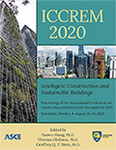International Conference on Construction and Real Estate Management 2020
Lifting Path Planning of Mobile Cranes Based on RRT Algorithm
Publication: ICCREM 2020: Intelligent Construction and Sustainable Buildings
ABSTRACT
Lifting operations of mobile cranes are always based on the experience of operators, leading to low efficiency as well as high accident rate because of the dynamic and complex construction environment. Thus, there is a strong need to develop an appropriate approach to guide the crane operations. In this paper, an improved rapidly-exploring random tree (RRT) algorithm is proposed for the automated lifting path planning of mobile crane. Considering the critical role of nearest neighbor search (NNS) in the implementation of RRT algorithm, an improved strategy consisted of generalized distance method and cell method for searching the nearest neighbor is developed. Both two methods have been tested in simulation-based experiments, with obvious improvements in computing time, number of nodes, and frequency of collision. Therefore, this improved RRT algorithm enables the rapid path planning of mobile cranes in a dynamic and complex construction environment, making it possible to enhance the efficiency and safety in crane lifting practices.
Get full access to this article
View all available purchase options and get full access to this chapter.
ACKNOWLEDGMENTS
We would like to thank the National Natural Science Foundation of China (Grant No. 51578318, 51208282) as well as Tsinghua University-Glodon Joint Research Centre for Building Information Model (RCBIM) for supporting this research. In addition, we would also like to thank Zhubang Luo for his assistance in computer engineering.
REFERENCES
Ali, M.S.A.D., Babu, N.R. and Varghese, K. (2005). “Collision Free Path Planning of Cooperative Crane Manipulators Using Genetic Algorithm.” Journal of Computing in Civil Engineering, 19(2), 182-193.
Bentley, J.L. (1975). “Multidimensional binary search trees used for associative searching.” Communications of the ACM, 18(9), 509-517.
Canny, J.F. (2003). “A Voronoi method for the piano-movers problem.” IEEE International Conference on Robotics and Automation, St. Louis, U.S.A. 530-535.
Chen, D.Z., Szczerba, R.J. and Uhran, J.J. (1997). “A framed-quadtree approach for determining Euclidean shortest paths in a 2-D environment.” IEEE Transactions on Robotics and Automation, 13(5), 668-681.
Chen, W.N. and Zhang, J. (2012). “Ant Colony Optimization for Software Project Scheduling and Staffing with an Event-Based Scheduler.” IEEE Transactions on Software Engineering, 39(1), 1-17.
Dorigo, M., Maniezzo, V. and Colorni, A. (1996). “Ant system: optimization by a colony of cooperating agents.” IEEE Transactions on Systems Man Cybernetics Part B Cybernetics A Publication of the IEEE Systems Man Cybernetics Society, 26(1), 29-41.
Gong, Y. (2012). Path planning algorithm for mobile crane in virtual lifting environment. Central South University, Changsha, China, 22-35 (in Chinese).
Haykin, S. (2008). Neural Networks: A Comprehensive Foundation. (3rd Edition).Macmillan, 71-80.
Karaman, S. and Frazzoli E. (2011). “Sampling-based algorithms for optimal motion planning.” The international journal of robotics research, 30(7), 846-894.
Kavraki, L.E., Latombe, J.C. and Overmars, M.H. (1996). “Probabilistic Roadmaps for Path Planning in High-Dimensional Configuration Spaces.” IEEE International Conference on Robotics and Automation, 566-580.
Kennedy, J. (2011). “Particle Swarm Optimization.” Proceeding of ICNN’95-International Conference on Neural Networks, Perth, Australia, 1942-1948.
Kuffner, J.J. and Lavalle, S.M. (2002). “RRT-connect: An efficient approach to single-query path planning.” International Conference on Robotics and Automation, Symposia Proceedings, San Francisco and C.A., U.S.A., 995-1001.
Lavalle, S.M. and Kuffner, J.J. (1999). “Randomized Kinodynamic Planning.” International Conference on Robotics and Automation, Detroit, U.S.A., 15(5), 378-400.
Lavalle, S.M. (1998). “Rapidly-exploring random trees : a new tool for path planning.” Research Report, 293-308.
Lee, T.K., Baek, S.H. and Choi, Y.H. (2011). “Smooth coverage path planning and control of mobile robots based on high-resolution grid map representation.” Robotics Autonomous Systems, 59(10), 801-812.
Li, A. and Li, Y. (2009). “Study on robot path planning method.” Mechanical Engineering and Automation, 5, 194-196.
Li, L., Ye, T., Tan, M. and Chen, X. (2002). “Present state and future development of mobile robot technology research.” Robot, 24(5), 475-480. (in Chinese).
Lin, H. I. (2015). “2D-Span Resampling of Bi-RRT in Dynamic Path Planning.” International Journal of Automation and Smart Technology, 4(4), 39-48.
Lin, Y., Wu, D., Wang, X. and et al. (2013). “Improving rrt-connect approach for optimal path planning by utilizing prior information.” International Journal of Robotics Automation, 28(2), 146-153.
Oommen, B.J., Iyengar, S.S. and Rao, N.S.V. (1987). “Robot navigation in unknown terrains using learned visibility graphs. Part I: The disjoint convex obstacle case.” Robotics and Automation, 3(6), 672-681.
Park, H. S. and Le, N. T. (2012). “Modeling and controlling the mobile harbour crane system with virtual prototyping technology.” International Journal of Control Automation and Systems, 10(6), 1204-1214.
Parsons, D. and Canny, J. (1990). “A motion planner for multiple mobile robots.” IEEE International Conference on Robotics and Automation, 1, 8-13.
Qureshi, A.H. and Ayaz, Y. (2015). “Intelligent bidirectional rapidly-exploring random trees for optimal motion planning in complex cluttered environments.” Robotics and Autonomous Systems, 68, 1-11.
Information & Authors
Information
Published In
ICCREM 2020: Intelligent Construction and Sustainable Buildings
Pages: 22 - 29
Editors: Yaowu Wang, Ph.D., Harbin Institute of Technology, Thomas Olofsson, Ph.D., Luleå University of Technology, and Geoffrey Q. P. Shen, Ph.D., Hong Kong Polytechnic University
ISBN (Online): 978-0-7844-8323-7
Copyright
© 2020 American Society of Civil Engineers.
History
Published online: Oct 14, 2020
Published in print: Oct 14, 2020
Authors
Metrics & Citations
Metrics
Citations
Download citation
If you have the appropriate software installed, you can download article citation data to the citation manager of your choice. Simply select your manager software from the list below and click Download.
